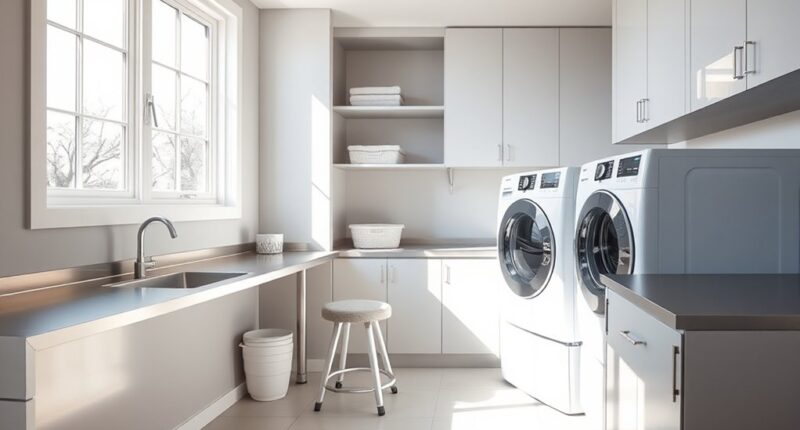In designing a laundry room with ergonomics that matter, focus on optimizing spatial layout to minimize bending, reaching, and twisting. Place hampers at waist level and position appliances for a natural front-facing approach. Use adjustable work surfaces, accessible storage, and strategic lighting to reduce strain. Guarantee flooring offers slip resistance and cushioning for safety and comfort. Applying these principles enhances efficiency and reduces injury risk—continue to explore how thoughtful design integrates these essential ergonomic elements seamlessly.
Key Takeaways
- Proper spatial arrangement minimizes reaching, bending, and twisting, enhancing efficiency and reducing physical strain during laundry tasks.
- Ergonomic work surfaces at elbow height and adjustable zones improve comfort and support natural body mechanics.
- Strategic placement of controls and storage within easy reach prevents overextension and awkward postures.
- Adequate lighting and slip-resistant flooring optimize safety, reduce eye strain, and support detailed tasks.
- Regular layout evaluations and user feedback ensure continuous ergonomic improvements and injury prevention.

Optimizing the ergonomic design of a laundry room directly impacts user efficiency and reduces physical strain, yet it’s often overlooked in standard layouts. A well-designed space minimizes unnecessary movements, promotes proper posture, and streamlines task sequences, which collectively enhance productivity and safety. When approaching ergonomic improvements, you must analyze the spatial arrangement carefully. Consider the typical workflow, from sorting clothes to folding, and ensure that each task zone is positioned to minimize reaching, bending, and twisting. For example, placing the laundry hamper at waist level near the sorting station reduces unnecessary bending, preventing lower back strain. Similarly, the placement of the washer and dryer should allow for a natural, front-facing approach, with controls within easy reach at a comfortable height—ideally between 36 and 48 inches from the floor—to avoid overextension or stooping.
The height of work surfaces plays a vital role in ergonomic efficiency. Countertops used for folding or sorting should be set at a height that permits a neutral shoulder position—typically around elbow level—reducing shoulder elevation and fatigue. Adjustable-height surfaces offer flexibility, accommodating users of different statures and preferences, thereby maintaining ideal posture during extended tasks. Storage solutions also demand attention; cabinets and shelves should be reachable without excessive stretching or bending. Using pull-out drawers instead of fixed shelves allows for better access and visibility, decreasing awkward postures and repetitive strain injuries.
Lighting design must complement ergonomic principles by eliminating shadows and reducing eye strain. Positioning adjustable task lighting directly over work zones ensures sufficient illumination for detailed tasks like inspecting clothing for stains or handling delicate fabrics. This reduces the tendency to lean forward or squint, maintaining proper neck alignment over longer periods. Flooring considerations are equally critical; slip-resistant, cushioned surfaces minimize fatigue and provide stability during movement, particularly when handling wet garments. Proper flooring also mitigates the risk of falls, especially when floors are wet or slippery.
Finally, integrating ergonomic principles involves ongoing assessment and iteration. You should evaluate the layout periodically, considering user feedback and ergonomic standards, to identify bottlenecks or discomfort points. Using tools like anthropometric data and ergonomic checklists can guide adjustments that maximize comfort and efficiency. Additionally, knowledge of entertainment and parks can inspire creative solutions for lighting, flooring, and layout aesthetics, making the workspace more pleasant and engaging. In essence, a technically precise, detail-oriented approach to laundry room ergonomics ensures that the space supports natural body mechanics, reduces injury risk, and enhances overall task performance, transforming a utilitarian area into a safe, efficient workspace.
Frequently Asked Questions
How Can I Customize My Laundry Room for Better Accessibility?
You can customize your laundry room for better accessibility by installing adjustable-height countertops and cabinets to reduce strain, ensuring controls are within easy reach, and adding ample lighting to improve visibility. Use non-slip flooring to prevent accidents, incorporate pull-out shelves for easier access to supplies, and add ergonomic fixtures like lever handles instead of knobs. These modifications optimize ergonomic efficiency, reducing physical effort and enhancing safety for all users.
What Budget Options Are Available for Ergonomic Laundry Room Upgrades?
You can enhance your laundry room ergonomics on a budget by installing adjustable shelves, which optimize reach and reduce strain. Replacing standard countertops with lightweight, durable materials like laminate lowers material costs while improving workspace efficiency. Incorporate removable or foldable laundry hampers to streamline movement and minimize clutter. Additionally, opt for affordable, ergonomic faucet handles and anti-fatigue mats that improve comfort during use without significant expense. These modifications provide measurable ergonomic benefits without exceeding budget constraints.
How Do I Maintain Ergonomic Features Over Time?
To sustain ergonomic features over time, regularly inspect your laundry workspace for wear or damage. Tighten loose fixtures, replace worn-out pads, and ensure adjustable components remain functional. Keep surfaces clean to prevent slips, and adjust workstation heights if your needs change. Establish a routine maintenance schedule, documenting any modifications. Training household members on proper ergonomic practices also prolongs the effectiveness of the design, reducing strain and preventing injury.
Are There Specific Brands Known for Ergonomic Laundry Room Products?
Think of ergonomic laundry products as the sturdy frame of a well-built bridge. Brands like Kohler, Kohler, and Moen are renowned for their precision-engineered fixtures and adjustable features, ensuring comfort and durability. They utilize high-quality materials, advanced design principles, and user-centered testing, making them dependable choices. Investing in these brands guarantees that your laundry space remains ergonomic over time, reducing strain and enhancing efficiency with consistent performance.
How Does Lighting Impact Ergonomics in Laundry Rooms?
Lighting substantially impacts ergonomics in your laundry room by reducing eye strain and enhancing task visibility. Proper illumination, such as bright, evenly distributed LED lighting, minimizes shadows and glare, enabling you to handle delicate fabrics and small items accurately. Adjustable lighting options allow you to tailor brightness levels for different tasks, reducing fatigue. Overall, strategic lighting design improves safety, efficiency, and comfort, helping you perform laundry chores more effectively and with less physical strain.
Conclusion
By prioritizing precise positioning, practical planning, and purposeful design, you optimize your laundry space for efficiency and ease. Attention to ergonomic essentials enhances comfort, reduces fatigue, and eliminates unnecessary effort. Thoughtful layouts foster fluid functionality, facilitating swift, stress-free tasks. Ultimately, meticulous measurement and mindful modification create a workspace where productivity prevails over pain, transforming laundry chores into manageable, meaningful moments. Embrace ergonomic excellence to elevate your laundry room into a model of modern, mindful design.








